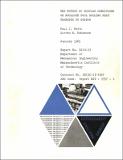The effect of surface conditions on nuceate pool boiling heat transfer to sodium
Author(s)
Marto, P. J.; Rohsenow, Warren M.
DownloadHTL_TR_1965_033.pdf (10.84Mb)
Other Contributors
Massachusetts Institute of Technology. Dept. of Mechanical Engineering.
Massachusetts Institute of Technology. Heat Transfer Laboratory.
Metadata
Show full item recordAbstract
A simplified theoretical model for bubble nucleation stability has been proposed, and an approximate stability criterion has been developed. This criterion contains both fluid and surfqce properties, and it predicts that nucleation for sodium should be unstable. Commercial grade sodium was boiled from a horizontal disc at pressures of 65 mm, 200 mm and 400 mm Hg absolute, with sodium temperatures ranging from 1200 0F to 1500 0F. Heat fluxes as high as 236,000 BTU/hr.ft.2 were attained. Boiler surface finishes ranged from highly polished mirror finishes to coarse, porous coatings. By following a prescribed cleaning and filling procedure, nucleate boiling results were generally reproducible for a given type surface. The effect of roughness as well as any aging and hysteresis effects were experimentally determined. Incipient nucleate boiling results are discussed as well as the effect of pressure and pool depth on the nucleate boiling curve. The effect of surface material, chemical treatment, heat flux and cavity geometry on nucleation stability was measured, and the experimental results agreed with the predictions of the proposed stability model.
Date issued
1965Publisher
Cambridge, Mass. : M.I.T. Dept. of Mechanical Engineering, [1965]
Other identifiers
14088542
Series/Report no.
Technical report (Massachusetts Institute of Technology, Heat Transfer Laboratory) ; no. 33.
Keywords
Boiling water reactors., Heat -- Transmission., Sodium.